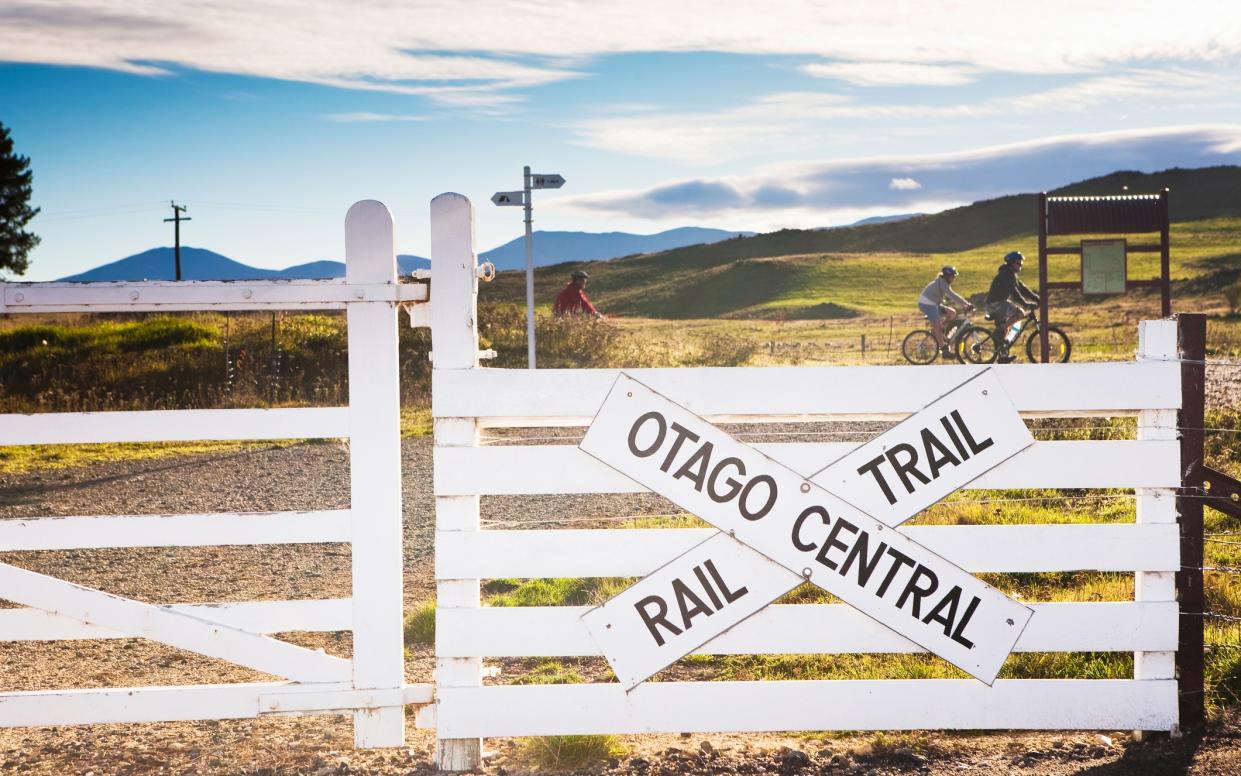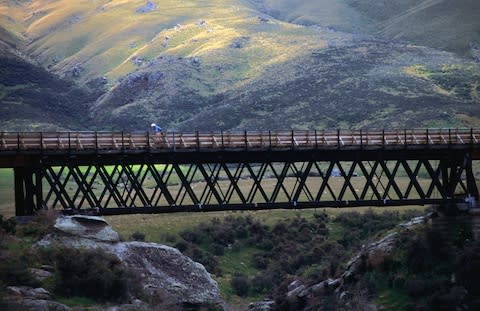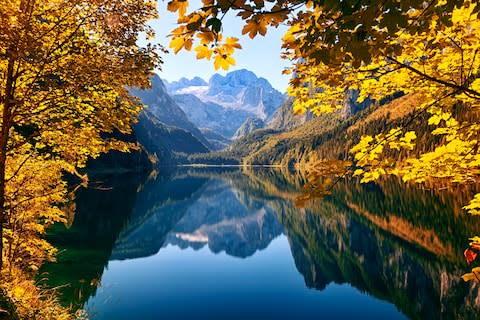Beautiful lost railways brought back to life

With the Government planning to restore British rail services lost in the 1960s to Beeching’s axe, Anthony Lambert considers how other closed lines have been given a new lease of life
Cycling the 93-mile (150km) Otago Central Rail Trail through the heart of New Zealand’s South Island was a revelation. Quite apart from the perfect pace to appreciate the landscape and the frequent stops to chat to people from a dozen countries, it made me realise how local activism can save an area on its beam ends. I met some of the women who had galvanised enough political and financial support to create a lifeline for local businesses – B&Bs, cafés, shops, even museums.
So successful has the trail been in halting rural depopulation by attracting tourists to the region that it has become a paradigm for the rest of New Zealand and elsewhere.
I was there researching a book, in which I explore some of the world’s seriously scenic stretches of rail track that are no longer in use – but that can be experienced by bike (as in Otago), by car, by foot, or even on horseback. Each has its own charm and each its own story.
That there are so many disused rail tracks is hardly surprising: most countries have suffered their equivalent of Dr Beeching as railways built in the 19th century became uneconomic in the face of road competition. Thousands of miles of railway were closed before governments realised they could be part of the future as well as the past. Countless communities regret the closures, but the trackbeds and remaining railway structures exert a powerful hold on our imaginations.
If exploring old railways on foot sounds, er, borderline geeky, the uber-trendy New York High Line shows just how much potential closed railways have when reinvigorated well.

Closer to home, a recent Channel 5 series, Walking Britain’s Lost Railways, has shown how, for many people, tracing closed railways provides a walk with a purpose. No organisation in Britain has done more to utilise old railway lines than Sustrans through its creation of the National Cycle Network (NCN). Trackbeds provide terrain for cycling, with space even on a single-track formation and gentle enough gradients to attract those averse to hill climbing.
A significant part of the NCN’s 14,000 miles (or 22,530km) has been built on old railway lines and it was the NCN that inspired the women behind the Otago project. There have been similar successes in Germany, Spain and the United States, where the national Rails-to-Trails Conservancy (railstotrails.org) has adapted 302 miles (486km) of track bed in Colorado, 400 miles (644km) in Maine and 1,071 miles (1,724km) in Washington State alone. In London the unwisely closed branch between Finsbury Park and Alexandra Palace has become the capital’s longest nature reserve, a four-and-a-half-mile corridor for more than 200 species of wild flowers, 22 species of butterfly and a dozen types of tree.

The bringing back to life of some of these glorious lines adds a new layer to already complex histories, touching on characters behind their construction and how they were woven into the fabric of the communities they served in a way that is hard to imagine in our atomised world of individual transport.
Though written about a Yorkshire station, this description, taken from a 1965 Women’s Institute scrapbook at Robin Hood’s Bay, speaks volumes. “As people gathered to await the arrival of the train they would meet friends and inquire about the journey, the newsagent could be there, also the local fishmonger and the other tradesmen waiting to collect their wares from the train. In the event of a breakdown or bad weather, the wife of the stationmaster would bring tea.”

Sometimes a railway was dominated by one person. The Virginia & Truckee Railroad in Nevada was part of the gold and silver enterprises developed by William Sharon into vehicles of such wealth that it became one of the most profitable railways in the world. A Pennsylvanian Quaker, Percival Farquhar, completed the railway that probably cost more lives per mile than any other – the 228-mile (367km) Madeira-Mamoré Railway, driven through the Amazon jungle to link the river with Bolivian rubber forests. Sections of both railways have retained operating sections for tourists on account of their stories.
Successive British governments have lacked the foresight to safeguard the linear integrity of closed railways, often making reopening prohibitively costly or physically impossible. A rare exception was the Borders Railway between Edinburgh and Tweedbank, which has helped boost tourism since its reopening in 2015 as well as exceeding its projected annual passenger numbers within seven months. Perhaps its success has inspired our current government, which has pledged to spend £500m restoring services cut by Beeching. The first towns to benefit could be Fleetwood in Lancashire and Blyth in Northumberland. Sir John Betjeman has been proved right when he predicted in 1963 that “railways are bound to be used again”. He just didn’t anticipate the many ways his forecast would be realised.
10 rail lines to revisit
1. Callander and Oban Railway
Arguably Scotland’s most scenic closed railway, the Callander and Oban line ran through some of the loveliest glens of the Central Highlands. So admired was the line that most of the Caledonian Railway’s tours featured it, some using a Pullman observation car. Today one of the most dramatic sections, through Glen Ogle, is part of NCN 7 between Glasgow and Inverness, with the excitement of wheeling or walking over the 12 masonry arches of Glen Ogle Viaduct high above the valley that the railway’s manager described with permissible hyperbole as the Khyber Pass of Scotland.

2. Somerset and Dorset Railway
Probably the most lamented railway in England, the Somerset and Dorset line wound through the most beautiful parts of the two counties. On summer weekends it carried a constant stream of trains between northern cities and the south coast, including the Pines Express between Manchester and Bournemouth. But for the rest of the year, it served a string of market towns that never generated enough revenue, once the roads smelt of fumes, and so it was closed in 1966. Its northern section has become the Two Tunnels Greenway through the LED-lit Devonshire and Combe Down tunnels, as part of a 13-mile (21km) loop using the Kennet & Avon Canal towpath.
3. The Ghan, Australia
You need a four-wheel drive vehicle to tackle the old route of the Ghan, the legendary train that has served the “red centre” of the country since the railway reached Alice Springs in 1929. When the new standard-gauge railway to Alice was opened in 1980 on a more westerly route, the old narrow-gauge line was abandoned, and its eerily remote stations and railway structures are now part of the week-long 652-mile (1,050km) Old Ghan Railway Heritage Trail between Alice and Port Augusta. Travel notes include places to find water at artesian springs.

4. Otago Central, New Zealand
Gold was the progenitor of this 147-mile (236km) railway into the heart of New Zealand’s South Island, but the rush was almost over by the time construction started from Dunedin in 1879, and it was 1921 before the western terminus at Cromwell was reached. Agricultural produce just about sustained the railway until road competition caused its closure west of Middlemarch in 1990.
Largely thanks to a group of far-sighted women in the Otago, the potential of the scenic route was realised with help of the Department of Conservation when the Otago Central Rail Trail was opened for cyclists and walkers in 2000. It became the first of many cycle trails across both islands, forming more than 1,553 miles (2,500km) of routes.

5. Kettle Valley Railway, Canada
When open, this railway through British Columbia’s rugged Kootenay Rockies attracted visits by those who relished challenging railroads, but it is probably far more widely known for its post-closure reincarnation as Canada’s finest bike trail. Stretching for 364 miles (586km) between Midway and Hope, it has become so popular that there is a book devoted to the cycling the journey and tour companies provide luggage transfers.
Mountain bikers may scoff at the relatively gentle grades of a converted railway line, but there is plenty of excitement en route, with tunnels and 18 wood and steel trestles across deep canyons.
kettlevalleyrailtrail.com; kettlevalleyrailway.ca
6. Florida East Coast Railway
Some people motoring along the very southern end of US Highway 1 down to Key West may be unaware they are driving along one of America’s most extraordinary railways. The Florida East Coast Railway was built through the determination of Henry Morrison Flagler. Construction of the 128 miles (206km) entailed some heroic engineering – its longest viaduct stretched for seven miles on 336 concrete piers. Opened in 1912 the railway carried freight for Cuba and trains from New York until a hurricane in 1935 caused damage beyond repair.

7. Newfoundland T’Railway
Railways came late to the island of Newfoundland; hauled by a Leeds-built locomotive, the first train over the 548-mile (882km) line ran from St John’s to Port aux Basques in 1898. A century later it was abandoned, but the railway’s value was recognised and today it forms the Newfoundland section of the Trans Canada Trail.
8. Vías Verdes, Spain
Spain has lost many of its most scenic railway lines, but no country has been as assiduous in giving them a second lease of life. More than 1,678 miles (2,700km) of lines have been opened as Vías Verdes, amounting to 117 itineraries. The routes are signed, and 98 railway stations have been restored. The longest is the 99-mile (160km) Ojos Negros II Greenway, partly over the track bed of a Sierra Menera mining railway, reached by trains on the Valencia-Teruel-Zaragoza railway.
viasverdes.com/en/principal.asp

9. Rio Grande Trail
Rail buffs in the United States have a special affection for the Denver and Rio Grande narrow-gauge lines that battled the mountain grades of Colorado, and two sections survive as heritage railways – the Durango & Silverton and the Cumbres & Toltec. The Rio Grande Trail follows the 42-mile (68km) long line through the Roaring Fork Valley with its soaring red cliffs that linked Glenwood Springs with Aspen. Beside the track are groves of willows, horse ranches and abundant wildlife. Just north of the world-famous ski resort of Aspen is Woody Creek, a historic community.
10. Salzkammergut lokalbahn, Austria
Few closures are as regretted as much as that of the railway between Bad Ischl and Salzburg, which shut in 1957. This railway served a string of villages, winding its way beside mountain-fringed lakes. Its charm is recalled by a museum at Mondsee housing some of its equipment. Much has become part of the 214-mile (345km) Salzkammergut Cycle Route, though people in the region campaign to reinstate the railway to alleviate traffic congestion.
salzkammergut.at; radurlaub.com/en

Lost Railway Journeys from Around the World by Anthony Lambert (White Lion; £25) is available on Amazon.


